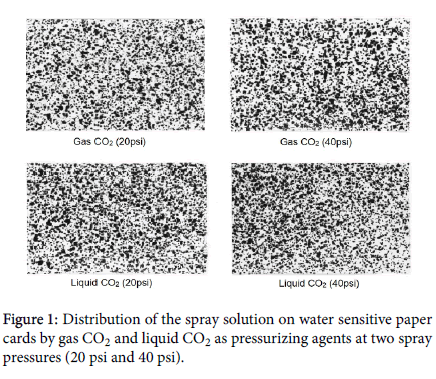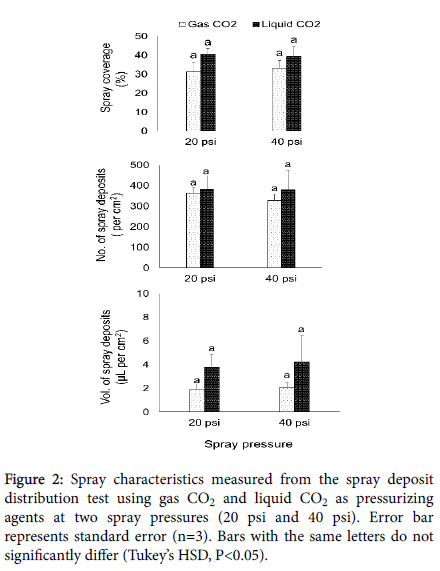Evaluation of Liquid CO2 as a Pressurizing Agent for Effective and Long-Term Pesticide Sprays
Received: 18-Sep-2018 / Accepted Date: 06-Dec-2018 / Published Date: 15-Dec-2018 DOI: 10.4172/2329-8863.1000408
Abstract
Carbon dioxide (CO2) pressurized sprayers continue to be an essential piece of spray application equipment for crop protection in many countries. In spite of several advantages of using CO2 sprayers for applying pesticides and foliar nutrition, concerns regarding the longevity of CO2 gas cylinders and the effort required to refill the tanks have become a setback for these sprayers in field conditions. This study evaluated the possibility of using liquid CO2 for pressurizing a spray system for a longer duration spray without compromising the spray quality. Spray deposit distribution tests on water sensitive papers demonstrated that spray coverage, number of spray droplets, and volume of spray droplets produced by liquid CO2 as the spray pressurizing agent are comparable to the conventional method of spraying using gas CO2. The results from this study suggest liquid CO2 is a good option as a pressurizing agent for attaining longer spray duration when applying pesticides using CO2 pressurized sprayer systems.
Introduction
The use of pesticides is an inevitable part of agricultural production as it contributes to the quantity and quality of yield. However, the application of pesticides must be carried out in such a way as to achieve efficient weed, pest, and disease management with minimal environmental contamination. Product being applied, weather conditions, and correct selection and calibration of the spray equipment are fundamental factors that define the effectiveness of a successful pesticide application. Additionally, a comfortable and longlasting spraying system will minimize operator fatigue and enhance the application practices.
Handheld sprayers are practical and versatile spray equipment systems that are useful for spraying a wide range of liquid applications, including herbicides, insecticides, fungicides and other agriculture chemicals. One of the most common applications for backpack (or knapsack) sprayers is for targeted application with minimal risk of offsite drift and damage to non-target species [1], mainly when used in conjunction with selective pesticides.
Of the various types of handheld sprayers, the pneumatic or compressed system backpack sprayer has the advantage of not requiring repeated pumping during spraying [2]. After filling with spray solution, the tank is pressurized with a carbon dioxide (CO2) cylinder. Another benefit of CO2 pressurized sprayers is that they produce relatively steady pressure, thus avoiding drawbacks experienced with instability in spray pressure, such as hampered spray quality and potential drift [3].
Despite many advantages of using CO2 backpack sprayers, concerns regarding the longevity of CO2 gas cylinders and the effort required to refill the tanks have limited use of these sprayers in field conditions. There are instances in which access to CO2 gas refill is prohibitively far from the site of spray application. An effective way to address this issue is to utilize liquid CO2 or compressed CO2 in place of gaseous CO2 for pressurizing the sprayer. The most common commercial uses of liquid CO2 are fire suppression systems, refrigeration and freezing in food processing and production, and plant growth stimulation in greenhouses. Relatively few research efforts have been directed towards devising a long-lasting spray equipment system that provides excellent application quality. The objective of this study was to evaluate the use of liquid CO2 for pressurizing a handheld CO2 backpack spray system for its potential for delivering optimal spray quality.
Materials And Methods
A CO2 pressurized backpack sprayer consists of a support frame with carrying bracket for transporting spray containers and cylinders of pressurizing agent that attaches to a user’s back with shoulder straps and a waist belt. Liquids are sprayed when CO2 from the aluminum carrier cylinder passes through an air hose to the plastic tank with spray solution, which then travels through the spray hose to a handheld spraying gun with nozzle. The high pressure exerted by the gas generates a fine mist of spray droplets through the nozzle. Spray pressure is monitored during operation by a pressure gauge on the spray boom handle; there is also a pressure regulator gauge on the CO2 carrier cylinder.
For this study, a backpack sprayer (R&D Sprayers, Bellspray Inc., Opelousas, LA) was selected that is commonly used in field studies for foliar application of pesticides and nutrients. This sprayer has an aluminum CO2 carrier cylinder of 2-liter capacity and a 3-liter plastic tank for holding spray solution and was fitted with a single-nozzle boom using a traditional flat fan nozzle (TeeJet, Spraying Systems Co., Wheaton, IL). Liquid CO2 was stored in a specialized tank containing a ‘dip tube’ which extends from the valve at the top to just above the bottom of the cylinder and delivers the liquid CO2 to the sprayer’s carrier cylinder.
For testing the spray deposit distribution using the backpack sprayer described above, water sensitive paper cards (3 × 2 inches, Syngenta Crop Protection AG, Basel, Switzerland) were used. These are stiff paper with a specially coated yellow surface which stains dark blue by aqueous droplets impinging on the paper. Both liquid and gas CO2 as a pressurizing agent were evaluated at two different spray pressures, 20 psi or 40 psi, which could be adjusted using the pressure regulator of the sprayer. Spray solution was sprayed perpendicularly onto the water-sensitive paper cards from a vertical distance of 15 cm for precisely 2 seconds. The spray was triplicated for each combination of pressuring agent and spray pressure. The water-sensitive papers were allowed to dry for a day, then scanned with office scanners at 600 dots per inch (dpi) grayscale (Figure 1). Images were analyzed using DepositScanTM software to calculate percent spray coverage, number of spray deposits (no. per cm2), and volume of spray deposits (μl per cm2) [4]. DepositScanTM is a scanning program developed by USDA Agriculture Research Service to evaluate spray deposit distribution in water sensitive paper cards. The software comprises of custom plugins that are used by an image-processing program to produce a number of spray deposit distribution measurements. The program can be installed on a computer and it works with a handheld or table scanner to scan spray deposits on target cards. It analyze the scanned image on the target card and then reports the individual droplet sizes, their distributions, the total number of droplets, and the percentage of area covered [5]. Additionally, the amount of spray solution that could be displaced by the liquid and gaseous CO2 was determined by weighing the respective liquid and gas-filled aluminum CO2 carrier cylinders before and after the sprays.
Results And Discussion
From the spray deposit distribution tests, it was observed that the spray coverage, number of spray droplets, and volume of spray droplets produced by liquid CO2 as spray pressurizing agent was comparable to the spray pressurized by gas CO2 (Figure 2).
There was no significant effect of spray pressures on the any of the spray characteristics measured from the distribution tests. Although statistically insignificant, the sprays pressurized by liquid CO2 produced better coverage and deposition. Spray coverage, volume of spray liquid, and number of spray droplets are important factors that determine the success of a targeted pesticide spray. The spray droplets drifting off-target can cause contamination of crops and the environment, particularly in sensitive areas located near water.
Also, of particular concern with compressed system sprayers is the close proximity of the applicator to the chemical spray [6]. The quality of a spray application depends not only on the amount of spray reaching its intended target, which can be measured by volume and number of spray droplets, but also on reduced potential for spray drift. A spray with better coverage and increased deposition on its target will be more effective than one poorly disbursed.
CO2 typically exists as a gas in air at standard temperature and pressure (STP). If the pressure is increased to approximately five times that of STP, it can adopt properties of a liquid. Typically, high-pressure liquid CO2 is produced by compressing the gaseous CO2 in multistage compressors to pressure of about 69 bars, followed by rigorous cooling. Because of the compressed state, approximately four times the amount of liquid CO2 can be stored in a 2-liter storage tank gas CO2 stored (Table 1).
| Pressurizing Agent* | Wt. of CO2 Stored Per Carrier Cylinder (g) | Calculated Vol. of Spray Solution Displaced (L) |
|---|---|---|
| Gas CO2 | 329 | 29 |
| Liquid CO2 | 1228 | 109 |
Table 1: Volume of spray solution displaced by gas and liquid CO2. *Stored in 2 L carrier cylinder at full capacity.
Tractor or all-terrain vehicle (ATV) mounted CO2-pressurized backpack sprayers, are commonly used for pesticide application [7]. Such vehicles equipped with compressed system sprayers would benefit from utilizing liquid CO2 as the pressurizing agent. Since significantly more liquid CO2 could be stored in the pressurizing tank compared to gaseous CO2, a higher volume of spray solution could be applied before needing to refill or replace the tank. Significant benefits would be seen when spraying large farms and plots, where frequent tank refills have been a hindrance to using this type of spray system. This would result in an effective pesticide application by improving cost efficiency and maintaining accuracy.
Conclusion
Pesticide applicators maintain a high level of interest in CO2 pressurized backpack sprayers because of their convenience, precision, and cost. However, lack of longevity of CO2 gas in a carrier cylinder is a major limitation in the use of these sprayers. Utilizing liquid CO2 cylinder as the pressure source for these sprayers will offer hours of continuous use on a single tank, making large-scale jobs more manageable to complete, such as spraying pesticides in large lawns, farms, and nurseries. Observations from the current study comparing conventional gas CO2 and newly evaluated liquid CO2 in backpack sprayers revealed that spray characteristics like spray coverage, number of spray droplets, and volume of spray droplets were comparable between the pressurizing agents tested. The results from this study suggest liquid CO2 is a viable, effective option for pressurizing sprayers to attain longer spray duration without frequently changing the CO2 tanks in handheld or vehicle mounted compressed system sprayers.
Acknowledgments
The authors thank Robert Riefer for laboratory assistance. The authors also thank Shea Teems for valuable suggestions during the preparation of the manuscript.
References
- Thistle HW, Bonds JA, Kees GJ, Fritz BK (2017) Evaluation of Spray Drift from Backpack and UTV Spraying. Transactions of the ASABE 60: 41-50.
- Shivarajakumar P (2014) Design and development of wheel and pedal operated sprayer.
- Viana RG, Ferreira LR, Ferreira MC, Teixeira MM, Rosell JR, et al. (2010) Volumetric distribution and droplet spectrum by low drift spray nozzles. Planta Daninha 28: 439-446.
- Sharpe SM, Boyd NS, Dittmar PJ, MacDonald GE, Darnell RL, et al. (2018) Spray penetration into a strawberry canopy as affected by canopy structure, nozzle type, and application volume. Weed Technol 32: 80-84.
- Zhu H, Salyani M, Fox RD (2011) A portable scanning system for evaluation of spray deposit distribution. Comput Electron Agric 76: 38-43.
- Matthews GA (1999) Application of pesticides to crops. World Scientific Publishing Company.
- Guice JB, Murdock EC, Toler JE (1988)Murdock EC, Toler JE (1988) Modi ication of an all-terrain vehicle for experimental and demonstration herbicide application. J Agron Educ..
Citation: Gairhe B, Kanissery R (2018) Evaluation of Liquid CO2 as a Pressurizing Agent for Effective and Long-Term Pesticide Sprays. Adv Crop Sci Tech 6: 408. DOI: 10.4172/2329-8863.1000408
Copyright: © 2018 Gairhe B, et al. This is an open-access article distributed under the terms of the Creative Commons Attribution License, which permits unrestricted use, distribution, and reproduction in any medium, provided the original author and source are credited.
Share This Article
Recommended Journals
Open Access Journals
Article Tools
Article Usage
- Total views: 3855
- [From(publication date): 0-2018 - Apr 02, 2025]
- Breakdown by view type
- HTML page views: 3050
- PDF downloads: 805


